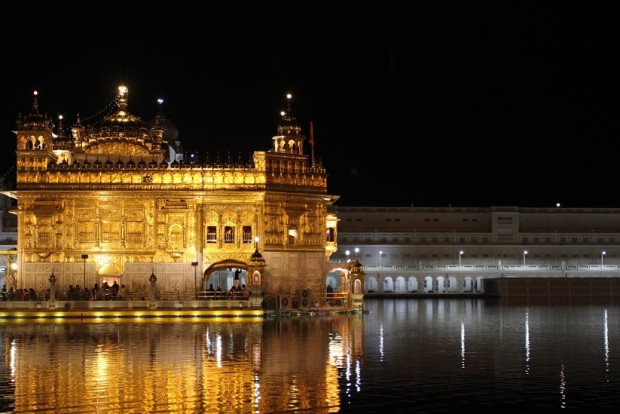AMRITSAR—It was hard to escape the presence of religion in its variety of forms on the bus ride to Amritsar from Delhi, be it a face-painted sadhu wandering the Grand Trunk Road, or churches built in a classic Sikh style with domed roofs, Gurudwaras, also dotted the highway, which made it hard to distinguish one pink and white building from another—until I noticed the cross at the top of one.
Along with the relics of Old India, we pulled over at a food plaza with a Subway and a McDonald’s restaurant. There are no Big Macs here, and definitely no beef. I had the aptly titled “McMaharaja” chicken burger. I must admit, the sight of a McDonald’s was like an oasis in a desert for some of us. As one of my classmates pointed out, “McDonald’s should have been in our comfort zone but it wasn’t.” Indeed, it was a different experience with delightful vegetarian options available. Choices like Aloo Wraps or Masala Paneer sandwiches were the surprising hits among this group of mostly carnivores. The lack of beef options was not an issue.
Back on the road, we drove along farmlands of harvested sugarcane and young wheat, lush green after the recent rain. The sluggish one-lane highway or the extra two and a half hours it took us to reach Amritsar mattered less because of the constant entertainment of sights like a towering humanoid structure, constructed entirely of car shells and a larger-than-life monument of Shiva, the Hindu god of destruction. There were statues of power lifters, horse-riders and owls, among other random things. For some, the statues perched atop their homes denote the profession they are in, like the power lifters (or “pehelwans”). For others, they are status symbols in this environment for visible opulence.
Flamboyant Punjabi architecture followed us to Amritsar. Our hotel, a Parthenon-inspired building, was a symbol of opulence on a street crammed with vegetable stalls, textile vendors and naan kiosks. Amritsar derives its name from the Amrit Sarovar at the Golden Temple. The city is considered to be the center of Sikh religion for many reasons. Some of us ventured out to Harmandir Sahib (The Golden Temple) after dinner at the hotel. This was the first religious sight we could go to without a guided tour or the prearranged meetings with leaders. This gave us a moment to pause and reflect on the chaos that characterized our first week in India. The peaceful night in the premises of the temple with its glittering magnificence and reflection of the gold tinted lights in the Amrit Sarovar was transcendental for many. Gurbaani, the hymns, composed by the gurus of Sikh religion that makes up the scriptures of the Guru Granth Sahib is played constantly at the temple. This added to the peace we were feeling as we sat cross-legged on the banks of the reflecting pool. The whole environment felt immersive even without any active physical actions on our parts other than sitting.
Here, I reflected on our bus-ride discussion with Professor Trivedi who brought up the point of looking beyond the facade when studying religion. The leaders from the many faiths that we have encountered so far have had very obvious narratives and spins on situations; they have also often deflected challenging questions. These leaders typically answer to some higher authority within their organizations. Yet when a liberal Hindu voice like that of Srivatsa Goswami, the head of the Radha Raman Mandir, who does not have to answer to anyone, speaks his mind we get a glimpse of the inner workings of a religious or a political leader.
There is also a journalism lesson to be gleaned from pushing past the facade. Professor Trivedi prodded us to think about the value of precise and efficient reporting in contrast to immersive ethnography-based reporting. In our current situation, where we have limited time in each city and a number of educational engagements arranged in advance, it is hard for us to take the latter approach. Some of us shared ways of finding a compromise between these two options. Advanced research, the willingness to adapt the story idea to the realities on the ground, being open to changes in schedule, and being persistent even in the face of drastic changes are just some of the tools we can use when finding a solution to our reporting challenges: in journalism as in religion, there is value in discovering the middle path.
